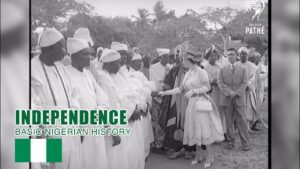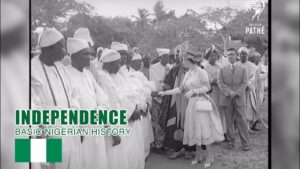
The Hausa-Fulani States and Their Political Structure

The Hausa-Fulani States of northern Nigeria represent a significant aspect of the region’s history, culture, and political development. These states, often grouped under the general term “Hausa-Fulani,” emerged as some of the most powerful and influential entities in West African history, with a rich political, social, and cultural fabric that has left a lasting legacy in modern Nigeria. The political structure of these states was complex, characterized by a blend of indigenous Hausa traditions and the influence of Fulani Islamic governance.
In understanding the Hausa-Fulani States, it is essential to recognize the roles of both the Hausa and Fulani people, as well as their interaction throughout history, particularly the Fulani Jihad of the early 19th century, which dramatically reshaped the political landscape of northern Nigeria. This article explores the development of the Hausa-Fulani states, their political structure, and the interaction between the Hausa and Fulani peoples.
The Origins of the Hausa States
The Hausa people are one of the largest ethnic groups in West Africa, primarily living in northern Nigeria and parts of Niger, Ghana, and Cameroon. The formation of the Hausa states, also known as the Hausa city-states, dates back to at least the 10th century AD. These early city-states were independent polities, each ruled by a local king known as the “Sarki”, and they flourished as centers of trade, culture, and Islamic learning.
The Hausa city-states were united by a common language and culture, but each state had its own political structure, local customs, and distinct ruler. The seven most prominent Hausa city-states were:
-
Kano
-
Katsina
-
Zaria
-
Gobir
-
Rano
-
Birnin Kebbi
-
Sokoto
These city-states developed around strategic locations such as trade routes and river systems, fostering economic and social development. Trade in goods such as salt, gold, cloth, and slaves was central to the prosperity of these states. Over time, the influence of Islam, introduced by Muslim traders and scholars from North Africa, began to take hold in the Hausa states, contributing to their political, social, and economic evolution.
The Fulani People and Their Influence
The Fulani people, originally pastoralists and traders, migrated into the Hausa-speaking region of West Africa over several centuries. The Fulani people were largely influenced by Islam, and their movement into the Hausa region coincided with the spread of Islamic teachings throughout the Sahel and the western Sudan. Their role in the political landscape of northern Nigeria would become especially significant following the Fulani Jihad of the early 19th century.
The Fulani had already established themselves as an influential group in Hausa society through intermarriage, trade, and religious leadership. However, it was during the Jihad of Usman dan Fodio (1804–1810) that the Fulani people made a permanent and lasting mark on the political structure of northern Nigeria.
The Fulani Jihad and the Establishment of the Sokoto Caliphate
The Fulani Jihad, led by Usman dan Fodio, was a religious and political revolution aimed at establishing an Islamic state in the Hausa region, which he viewed as corrupt and morally decadent. The Jihad was driven by a desire to purify Islam, implement Sharia law, and create a unified state under Islamic governance.
Usman dan Fodio’s followers, known as the Sokoto Caliphate, succeeded in overthrowing several of the Hausa rulers in a series of military campaigns that spanned the early 19th century. The Jihad was not just a religious conquest, but a political one, and it led to the creation of the Sokoto Caliphate, one of the largest and most influential Islamic empires in West Africa.
Following the success of the Fulani Jihad, the Hausa city-states were reorganized under the control of the Sokoto Caliphate, with a hierarchical system of leadership that blended Fulani and Hausa governance. The Caliphate was divided into several emirates, each ruled by an Emir (a title that replaced the earlier Hausa rulers, known as Sarkis). These emirates were governed according to Islamic principles, which included the rule of law based on Sharia and the central authority of the Sultan of Sokoto as the spiritual and political leader of the empire.
The Political Structure of the Hausa-Fulani States
The political structure of the Hausa-Fulani states under the Sokoto Caliphate was highly centralized yet decentralized in practice. While the Sultan of Sokoto was the supreme ruler, the administration of the empire was divided into regions, each governed by an emir. The emirs were typically appointed by the Sultan and were responsible for administering justice, collecting taxes, and maintaining security within their respective emirates.
Here’s a breakdown of the key political components:
-
Sultan of Sokoto
The Sultan of Sokoto was the spiritual and political head of the Caliphate and the most powerful figure in the empire. He was seen as the representative of the Prophet Muhammad on earth and held ultimate authority in both religious and secular matters. The Sultan’s authority extended across the entire Caliphate, but his direct control was most evident in Sokoto and the central regions of the empire. -
Emirs
Each emirate within the Sokoto Caliphate was headed by an emir, who ruled over a defined territory or city-state. The emirs were responsible for enforcing Sharia law, administering justice, and collecting taxes. They were also tasked with maintaining the loyalty of their people and managing relationships with neighboring empires and states. -
Council of Advisers
Beneath the Sultan and the emirs was a complex system of advisers and officials who helped manage the administration of the Caliphate. These included military commanders, religious leaders, and bureaucrats who helped in the day-to-day running of the state. These officials were often drawn from both the Fulani and the Hausa elite, reflecting the blend of the two cultures in the empire. -
Sharia Courts
The Sokoto Caliphate was governed by Sharia law, and Islamic scholars (known as Qadis) played an important role in administering justice. The Qadis were responsible for interpreting and applying Islamic law to resolve disputes, handle criminal cases, and oversee the social behavior of the people. Their role was integral to the functioning of the state, as they ensured that the policies of the rulers aligned with Islamic principles. -
Military
The military was a key component of the Hausa-Fulani political structure. The Caliphate maintained a strong military to defend its borders, suppress rebellion, and ensure loyalty to the Sultan. The army was led by senior officers, many of whom were Fulani, and it was instrumental in expanding the empire’s territory through conquest and maintaining order within its regions. -
Local Governance
While the emirs held significant power, local governance was often still influenced by traditional Hausa rulers (Sarkis) and local chieftains. These local leaders managed their territories in cooperation with the emirate, and the relationship between the central and local governments was one of negotiation, collaboration, and at times, conflict. The integration of traditional Hausa leadership with the Fulani governance structure allowed the Sokoto Caliphate to maintain control over a diverse and multi-ethnic population.
Economic and Social Organization
The Hausa-Fulani states were agricultural societies, with farming, trade, and animal husbandry forming the backbone of the economy. The Hausa people were known for their expertise in agriculture, cultivating crops such as millet, sorghum, yams, and cotton. The Fulani, on the other hand, were predominantly cattle herders, and their pastoral lifestyle complemented the agricultural economy of the Hausa states.
Trade played a central role in the economic prosperity of the Hausa-Fulani states. The empire’s strategic position along trans-Saharan trade routes allowed it to engage in long-distance trade with North Africa, the Middle East, and other parts of West Africa. Goods such as salt, gold, ivory, and textiles were traded, enriching the economy and increasing the power of the states.
Socially, the Hausa-Fulani states were organized hierarchically. At the top were the aristocratic elites, including the emirs and their families. Below them were the merchants, scholars, and military officers, followed by the common people, farmers, and slaves. The Fulani people, due to their military and religious roles, often occupied prominent positions within the empire’s structure.
Decline and Legacy
The Sokoto Caliphate remained a powerful entity in northern Nigeria until the late 19th century, when British colonialism began to erode its power. The British conquest of northern Nigeria in 1903 led to the eventual dissolution of the Caliphate. However, the legacy of the Hausa-Fulani political structure has endured in modern Nigeria. Many of the emirs and their descendants continue to hold symbolic authority, and the influence of Islam and Sharia law remains strong in the region.
The political organization of the Hausa-Fulani states and their blend of indigenous and Islamic governance laid the foundation for modern political structures in northern Nigeria. Today, the Hausa-Fulani people continue to play an important role in Nigerian politics, culture, and religion.
Thank you for following us incase you find any error in our contents please kindly send us mail or you need additional information you want us to add to any history kindly send us because all what we are posted was generated according to what we see online or we have acknowledged about in this case we can’t perfect in 100% kindly correct us in any aspect you find that’s need.
Noted:- We are not copy from any blog if you fund one your line or content is attach to our post kinky report to our [email protected] and we promise you we are going to rephrase it immediately thanks so much we love you all.
Leave a Reply